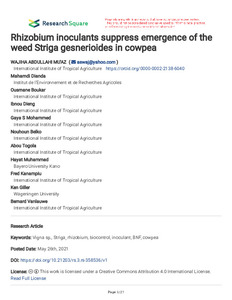| dc.contributor.author | Mu'az, W.A. |
| dc.contributor.author | Dianda, M. |
| dc.contributor.author | Boukar, O. |
| dc.contributor.author | Dieng, I. |
| dc.contributor.author | Mohammed, G.S. |
| dc.contributor.author | Belko, N. |
| dc.contributor.author | Togola, A. |
| dc.contributor.author | Muhammad, H. |
| dc.contributor.author | Kanampiu, F. |
| dc.contributor.author | Giller, K. |
| dc.contributor.author | Vanlauwe, B. |
| dc.date.accessioned | 2022-02-01T10:33:19Z |
| dc.date.available | 2022-02-01T10:33:19Z |
| dc.date.issued | 2021 |
| dc.identifier.citation | Mu'az, W.A., Dianda, M., Boukar, O., Dieng, I., Mohammed, G.S., Belko, N., ... & Vanlauwe, B. (2021). Rhizobium inoculants suppress emergence of the weed Striga gesnerioides in cowpea. Research Square, 467, 1-27. |
| dc.identifier.issn | 2693-5015 |
| dc.identifier.uri | https://hdl.handle.net/20.500.12478/7334 |
| dc.description.abstract | Cowpea is a grain legume of major importance in sub-Saharan Africa where it is cultivated by smallholder farmers on poor soils and production is often constrained by the parasitic weed Striga gesnerioides. Experiments were conducted to assess the potential of rhizobium inoculation in mitigating Striga infestation and increasing cowpea productivity. We tested under basal P application and artificial S. gesnerioides inoculation the impact of cowpea genotypes (G) (nine Striga-resistant and 11 Striga– susceptible genotypes) and bradyrhizobium inoculation (N) (two bradyrhizobium strains USDA3384 and IRJ2180A, and uninoculated control) on Striga dynamics and cowpea yield. Additional treatments included N supplied as urea (with and without), and no input (i.e., soil inherent N and P) that served as negative check. A first experiment was carried out in potted sterile soils in the screen house excluding addition of N-fertilizers. Significant G x N interactions were observed in counts of nodule (P = 0.012), Striga attachment (P < 0.0001) and emergence (P = 0.005), and cowpea shoot growth (P = 0.016). Cowpea nodulated poorly across host lines, Striga counts were the lowest for resistant varieties with no emerged plants. Rhizobial inoculants depressed Striga counts with consistent differences found across cowpea genotypes. Inoculation with IRJ2180A performed the best against Striga attachment in resistant genotypes, and its emergence in susceptible genotypes. In the field trial, nodule numbers were lowest in cowpea without inputs (P < 0.0001). The G x N interaction was significant in emerged Striga plants (P < 0.0001). Resistant genotypes were free of emerged Striga while for susceptible ones, Striga emergence was the highest without any input addition. Significant G x N interaction was observed in cowpea grain yield (P < 0.0001). Yield response to inoculation was most obvious for resistant genotypes inoculated with the strain IRJ2180A (P = 0.0043). The integrated use of Striga-resistant cowpea lines and elite bradyrhizobium inoculant under moderate application of P-based fertilizer could be a promising approach for mitigating Striga infestation and increasing productivity. |
| dc.description.sponsorship | Bill & Melinda Gates Foundation |
| dc.format.extent | 1-27 |
| dc.language.iso | en |
| dc.subject | Cowpeas |
| dc.subject | Striga |
| dc.subject | Grain Legumes |
| dc.subject | Smallholders |
| dc.subject | Genotypes |
| dc.subject | Productivity |
| dc.title | Rhizobium inoculants suppress emergence of the weed Striga gesnerioides in cowpea |
| dc.type | Journal Article |
| cg.contributor.crp | Maize |
| cg.contributor.crp | Roots, Tubers and Bananas |
| cg.contributor.affiliation | International Institute of Tropical Agriculture |
| cg.contributor.affiliation | Institut de l'Environnement et de Recherches Agricoles |
| cg.contributor.affiliation | Bayero University Kano |
| cg.contributor.affiliation | Wageningen University and Research Centre |
| cg.coverage.region | Africa |
| cg.coverage.region | West Africa |
| cg.coverage.country | Nigeria |
| cg.coverage.hub | Central Africa Hub |
| cg.coverage.hub | Headquarters and Western Africa Hub |
| cg.researchtheme | Biotech and Plant Breeding |
| cg.researchtheme | Natural Resource Management |
| cg.researchtheme | Plant Production and Health |
| cg.identifier.bibtexciteid | MUAZ:2021 |
| cg.authorship.types | CGIAR and developing country institute |
| cg.iitasubject | Agronomy |
| cg.iitasubject | Cowpea |
| cg.iitasubject | Food Security |
| cg.iitasubject | Grain Legumes |
| cg.iitasubject | Plant Breeding |
| cg.iitasubject | Plant Health |
| cg.iitasubject | Plant Production |
| cg.journal | Research Square |
| cg.notes | Open Access Article; Published online: 26 May 2021 |
| cg.accessibilitystatus | Open Access |
| cg.reviewstatus | Peer Review |
| cg.usagerightslicense | Creative Commons Attribution 4.0 (CC BY 0.0) |
| cg.targetaudience | Scientists |
| cg.identifier.doi | https://dx.doi.org/10.21203/rs.3.rs-358536/v1 |
| cg.iitaauthor.identifier | Ousmane: 0000-0003-0234-4264 |
| cg.iitaauthor.identifier | Abou TOGOLA: 0000-0001-6155-8292 |
| cg.iitaauthor.identifier | Fred Kanampiu: 0000-0002-2480-6813 |
| cg.iitaauthor.identifier | bernard vanlauwe: 0000-0001-6016-6027 |
| cg.futureupdate.required | No |
| cg.identifier.volume | 467 |

